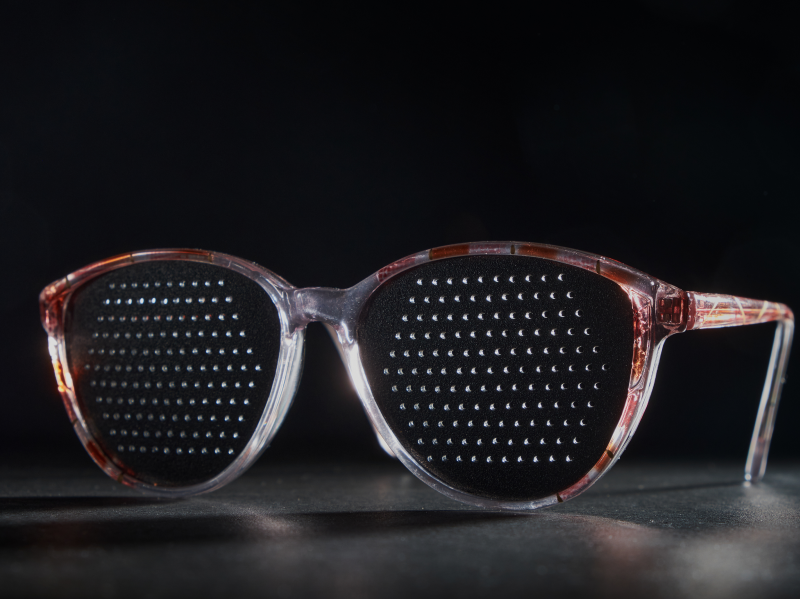What are pinhole glasses and why are they used? Do pinhole glasses improve eyesight? There is a lot more you wanted to know about the glasses, that looks way different from the regular clear glasses.
Here let’s delve deeper into the topic and understand the magic of these dark dotted glasses and how they help in vision improvement.
What exactly are pinhole glasses?
Pinhole glasses are also known as “stenopeic glasses” are essentially made of plastic with a grid of tiny holes in the place of lenses. With the primary purpose of removing the indirect rays of light distorting your vision. Pinhole glasses help in many refractive errors and focus clearly.
How do pinhole glasses work?
Before understanding the working of pinhole glasses to help your vision, let’s talk about how glasses or contact lenses work. If someone is suffering from a refractive error, prescription glasses refract the light passing through them to converge on the retina, to enable them to see clearly.
Instead, Pinhole glasses work very differently by limiting the light incident on them, thus eliminating the unfocused rays that cause blur circles in front of the retina and allowing only focused rays to form sharp images.
So, pinhole glasses work the same as the effect created while you squint to adjust the light reaching the eye.
Who might benefit from pinhole glasses?
Pinhole glasses have several uses. Some people with a refractive error often use these glasses to treat nearsightedness or astigmatism. They are popularly used by eye doctors, optometrists or ophthalmologists to better determine any vision impairment.
Doctors use them as a diagnostic tool for checking the prescription of one eye while covering the other eye completely with an occluder.
Here the pinhole glasses help you improve your visual acuity when reduced vision is due to some refractive error. But, if the pinhole doesn’t help, it might be an indication of another eye problem.
Moreover, they are also used to effectively determine if a person is suffering from corneal distortion or cataracts.
The process of detecting the vision impairment involves focusing light on the eye to determine whether the vision capability of eye lenses behind the cataract is worth undergoing surgery or not.
Do pinhole glasses work to improve vision?
In general, pinhole glasses are only used as a diagnostic tool by doctors to determine eye alignment. Meanwhile, they are not an ideal choice for everyday use. However, some people claim using pinhole glasses to treat myopia, hyperopia and glasses for astigmatism, with no conclusive evidence or a trial to prove their effectiveness.
Pinhole glasses for myopia:
For a person suffering from myopic or nearsightedness, pinhole glasses may help you see clearly.
Even though we can’t doubt their effectiveness in making an object look more clearer while blocking light rays out from the focus. They may affect image quality and form a dimmer image instead of usual.
Furthermore, The pinhole glasses only allow optimally direct light to pass through them while blocking the part of non-optimal direct and peripheral vision. Thus, again making them aren’t functional for everyday use and activities like driving or operating machinery.
Pinhole glasses for astigmatism:
Same as the case with people with astigmatism. Pinhole glasses simply block the light rays that aren’t aimed to converge on the right spot of the retina and only allow focused light to pass.
Admittedly, they don’t treat your eye alignment permanently and you will get back to your usual vision as soon as you take them off.
Pinhole together with eye exercise:
Some people also support pinhole glasses suggesting using them together with eye exercising can improve your vision permanently. Though it may seem true for one or two fortunate cases when people saw a vision improvement through eye exercising, there is no evidence to support the concept when pinhole cure or permanently address refractive error.
Essentially when you wear pinhole glasses, they give you extra clarity but it is only for a period you wear them.
Don’t reduce eye strain:
Another myth that surrounds pinholes is that they help reduce eye strain caused by pseudomyopia, a spasm in focusing muscle. But it is not true, pinhole doesn’t address the cause of digital eye strain. Moreover, wearing them while bling watching or for screen usage, can only make the symptoms worse with headache and tired eyes.
Your best bet here is to use blue light glasses to eliminate glare from digital devices hitting your eye and wear contact or prescription glasses for vision improvement.
How to make pinhole glasses at home:
Looking to make pinhole glasses for yourself to understand what wearing them looks like? Here are the simple steps you can try at home to make one.
- Take an old pair of glass frames you no longer use.
- Next, wrap a piece of aluminium foil over it.
- Take a sewing needle or a pin.
- Poke holes on the aluminium foil with the needle.
With the pair in hand, you are good to enjoy clearer vision with a pinhole glass pair made by you.
Wrapping up:
Today many companies, including those advertising on the internet, are also claiming pinhole glasses as a treatment of myopia, reducing myopia and digital eye strain, improvement in vision or other exaggerated benefits.
Hopefully, the article helps you understand the truth behind all those claims. Now instead of falling for the temptation of the magic with pinhole glasses, invest in a high-quality pair of contact lenses or eyeglasses.






